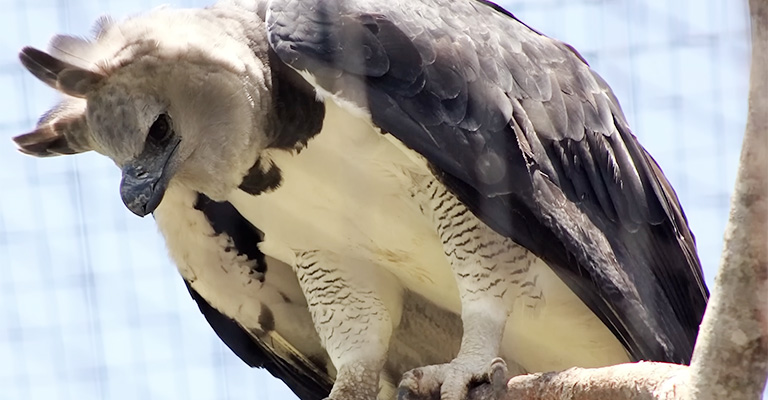Harpy eagles, with their striking appearance and impressive size, have long been a source of fascination and curiosity. These majestic birds of prey are renowned for their powerful talons.
They can easily dispatch their prey, often large mammals and birds, in the dense rainforests of Central and South America. This has led to questions about their potential danger to humans. Are harpy eagles dangerous to humans?
In this article, we will delve into the world of harpy eagles to explore whether the myths and legends surrounding their supposed danger to humans are founded in truth.
We will examine their behavior, habitat, and interactions with humans to provide a comprehensive understanding of the risks (or lack thereof) they pose to people in their natural environment.
So, if you’ve ever wondered whether these magnificent raptors could be a danger to humans, read on to uncover the facts behind the legends.

Are Harpy Eagles Dangerous to Humans?
Known for their impressive size and striking appearance, harpy eagles have long been subjects of fascination and curiosity. However, when it comes to assessing their danger to humans, it’s important to understand their behavior, habitat, and interactions with people.
Physical Characteristics and Habitat
Harpy eagles are among the largest and most powerful eagles in the world. They have a wingspan that can reach up to 7 feet (2.1 meters) and can weigh between 10 to 20 pounds (4.5 to 9 kilograms).
These birds have sharp talons, strong beaks, and powerful legs, which make them formidable hunters in their natural habitat. Their distinctive appearance includes a crown of feathers on their heads, which gives them an imposing and regal presence.
Harpy eagles are primarily found in the canopy of tropical rainforests in Central and South America. They inhabit regions ranging from southern Mexico to northern Argentina and throughout the Amazon basin.
Their range includes countries like Brazil, Peru, Venezuela, and Panama, among others. These dense, lush rainforests provide the harpy eagles with an abundant supply of prey.
Diet and Hunting Behavior
Harpy eagles are carnivorous predators with a diet consisting mainly of tree-dwelling animals. Their preferred prey include sloths, monkeys, tree-dwelling reptiles, and other arboreal creatures. Their powerful talons and strong beaks enable them to capture and subdue their prey efficiently.
The harpy eagle’s hunting technique involves stealth and ambush. They are known for perching silently in tall trees, often near known nest sites, and waiting for potential prey to come within striking distance.
When an opportunity presents itself, they launch a surprise attack, gripping their prey with powerful talons. This hunting strategy is specialized for capturing prey in the tree canopy.
Interactions with Humans
In general, harpy eagles are not considered dangerous to humans. They are shy and elusive birds, preferring to avoid human presence. Encounters between harpy eagles and humans are infrequent due to the remote and inaccessible areas in which they reside.
While harpy eagles may not pose a direct threat to humans, they can become vulnerable when faced with human activities that threaten their natural habitat.
Deforestation, illegal pet trade, and habitat destruction are some of the significant challenges these magnificent birds face. Conservation efforts are crucial to protect their populations and their rainforest habitats.
Conservation Status
Harpy eagles are classified as “Near Threatened” by the International Union for Conservation of Nature (IUCN). Their population is declining primarily due to habitat loss.
As pristine rainforests are increasingly cleared for agriculture, logging, and other human activities, harpy eagles lose their homes and access to prey.
Conservation organizations and governments in countries where harpy eagles are found are working to protect their habitats and address the challenges these birds face.
Mythology and Folklore
Harpy eagles have long captured the human imagination. In many indigenous cultures of the Americas, these eagles are revered and play significant roles in local mythology and folklore. They are often seen as symbols of power and spirituality, rather than threats to human safety.
Why Do Harpy Eagles Become Aggressive to Humans?

Harpy eagles (Harpia harpyja) are generally not known for being aggressive towards humans. In fact, these magnificent birds of prey are shy and elusive by nature, preferring to avoid human interactions whenever possible.
However, there can be situations where harpy eagles may display defensive or protective behavior, and it’s important to understand the circumstances that can lead to such encounters.
Protecting Their Nesting Sites
One of the primary reasons harpy eagles might exhibit aggression towards humans is to protect their nesting sites. Harpy eagles are incredibly territorial when it comes to their nests and offspring.
These nests are typically located high in the canopy of dense rainforests, making them challenging to access for predators, including humans.
When humans unknowingly approach or attempt to interfere with a nesting site, harpy eagles may perceive them as a threat and exhibit defensive behaviors.
Feeling Cornered or Threatened
In some rare instances, harpy eagles may become aggressive if they feel cornered or threatened. This can occur if a human approaches too closely, making the eagle uncomfortable or if someone inadvertently disrupts their hunting or feeding activities.
Harpy eagles may respond with aggressive displays or vocalizations in an attempt to deter the perceived threat.
Protective Parental Instincts
Like many animals, harpy eagles are protective parents. When they have chicks in the nest, they become especially vigilant in guarding and caring for their young.
If humans approach a nest with chicks, the adult eagles may become defensive and exhibit aggressive behaviors to protect their offspring.
Provoked by Human Interference
Direct human interference, such as illegal wildlife trafficking or attempts to capture harpy eagles, can lead to aggressive responses.
The stress and danger posed by these activities can provoke harpy eagles to exhibit defensive behaviors, as they perceive humans as a direct threat to their well-being.
Unusual Circumstances
In very rare and unusual circumstances, harpy eagles may exhibit aggression towards humans if they feel particularly threatened or if they have had negative prior experiences with humans.
However, such cases are extremely uncommon. It’s important to note that harpy eagles do not typically seek out confrontations with humans.
Their natural instincts are focused on hunting, feeding, and protecting their nests and offspring. Aggressive behavior towards humans is usually a last resort and is often a response to perceived threats.
How to Prevent Their Attack?

Preventing attacks by harpy eagles is generally not a common concern, as these birds are not known for actively seeking out or attacking humans.
However, if you find yourself in an area where harpy eagles are present or near their nests, it’s essential to take certain precautions to minimize any potential risks:
Maintain a Respectful Distance
The most effective way to prevent any potential interaction with harpy eagles is to maintain a respectful distance from them and their nests.
If you encounter a harpy eagle in the wild, observe it from a distance and avoid approaching too closely. Harpy eagles are more likely to perceive you as a threat if you get too close to their nest or their territory.
Do Not Disturb Nests
Harpy eagles are particularly protective of their nesting sites and offspring. Avoid disturbing their nests or attempting to access them. Harpy eagles may become defensive if they perceive a threat to their young.
Quiet and Calm Behavior
When you are in the presence of harpy eagles or their nesting areas, try to maintain quiet and calm behavior. Sudden loud noises, movements, or disruptive activities may startle them, potentially leading to defensive behavior.
Stay Informed
If you are in an area where harpy eagles are known to inhabit, it’s a good idea to stay informed about their presence and nesting sites. Local authorities or conservation organizations may provide information and guidelines to ensure your safety and the well-being of the eagles.
Observe from a Safe Distance
If you are lucky enough to spot a harpy eagle in the wild, use binoculars or a telephoto lens to observe them from a safe distance. This allows you to appreciate their beauty and behavior without getting too close.
Respect Protected Areas
In many regions where harpy eagles are found, there are protected areas or national parks. Follow the rules and regulations of these areas, as they often include guidelines for wildlife viewing and conservation.
FAQs
How big are harpy eagles?
Harpy eagles are one of the largest and most powerful eagle species in the world. They can have a wingspan of up to 7 feet (2.1 meters) and weigh between 10 to 20 pounds (4.5 to 9 kilograms).
Where can harpy eagles be found?
Harpy eagles are native to the tropical rainforests of Central and South America. Their range includes countries like Brazil, Peru, Venezuela, Panama, and others. They primarily inhabit remote and inaccessible areas within these rainforests.
Are harpy eagles endangered?
Harpy eagles are classified as “Near Threatened” by the International Union for Conservation of Nature (IUCN). Their population is declining due to habitat loss and human activities.
What do harpy eagles eat?
Harpy eagles are carnivorous predators with a diet consisting mainly of tree-dwelling animals. Their preferred prey include sloths, monkeys, tree-dwelling reptiles, and other arboreal creatures.
How dangerous are harpy eagles?
Harpy eagles are not generally considered dangerous to humans. They are shy and elusive birds that prefer to avoid human presence. While they can exhibit defensive behavior if they feel threatened or if their nests are approached, they do not actively seek out confrontations with humans.
Conclusion
While harpy eagles are undoubtedly formidable predators, their danger to humans is largely a myth. These magnificent birds primarily inhabit remote rainforests and are known to be extremely elusive and rarely encountered by people.
Their natural behavior does not involve aggression towards humans, and they tend to avoid human presence. Moreover, efforts to conserve harpy eagle populations and protect their habitat help minimize any potential risks.
So, for those fortunate enough to catch a glimpse of a harpy eagle in the wild, there’s no need to fear. Instead, it’s an opportunity to witness one of the most incredible and iconic species of birds of prey, a testament to the beauty and diversity of the natural world.
While harpy eagles are indeed powerful and awe-inspiring, they are not a danger to humans who respect their territory and observe them from a respectful distance.